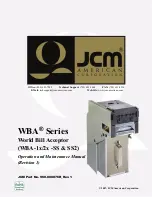
PC-45X(E2)
Page5
Texmate, Inc. Tel. (760) 598-9899
THEORY AND APPLICATION OF LIQUID CRYSTAL DISPLAYS
ELECTRICAL CHARACTERISTICS
- Electrically, liquid crystal displays
function like capacitors and, unlike LED's, are driven with an AC signal.
This AC signal is necessary to maintain the electric field required to rotate
the liquid crystal molecules. The LCD drive circuitry used for Texmate
displays puts out a 60Hz square wave signal which is truly symmetrical and
contains no DC components. Fig. 3 shows the typical AC drive signal's
relationship between the common back plane and the individual segment
elements. A segment is turned on when its drive signal is 180° out of
phase with respect to the back plane. A segment is turned off when its
drive signal is in phase with the back plane so that there is no net voltage
between the back plane and the segment. Fig. 4 explains operation of he
internal logic circuitry used to create the AC drive signal described in Fig. 3.
The field-effect liquid crystal display is the most advanced and reliable
liquid crystal display available today. Its operation depends on changing
the optical properties of the liquid crystal by applying an electric field.
The effect of this change is in turn, made visible by polarizers placed on
each side of the display cell.
TEMPERATURE SPECIFICATIONS
- The extremely pure state-of-the-art
LC materials used in Texmate displays provide a wide operating tempera-
ture range of -10°C to +60°C and a storage temperature range of -30°C to
+70°C. Maintaining the display at temperatures above 70°C for sustained
periods (days), or above 100°C for shorter times (minutes) can cause
permanent damage ot the LC material and/or polarizing film. At the low
end of the temperature range, there is no fixed breakdown temperature.
Instead, the display response time increases as molecular movement is
slowed down due to the increased viscosity of the LC fluid. At approximate
-
ly -15 to -20°C the LC compound undergoes first- or second-order phase
changes and ceases to operate. Such changes, however, are reversible
and not damaging. For example, LCD'S immersed in liquid nitrogen have
returned to normal operation after a brief warmup period.
CAUTION
- If a DC component is introduced into the display, electrolysis
occurs and the transparent conductors which form the individual display
elements will, in time, be destroyed. A DC component can be created by
leakage or inadvertent connection to system ground of unused display
elements such as decriptors and decimal points. For this reason it is
recommended that unused display elements be connected to to the back
plane output drive pin which is provided on all Texmate LCD meters. The
back plane signal will then drive these unused elements to an off condition.
Short term application of a DC signal will not damage the display and ,
in fact, the display test function in most Texmate meters utilizes a DC
signal to light up all segments for test purposes. This function, however,
is only intended for momentary usage and if left activated for longer than
24 hours, damage to the display will occur.
Liquid crystal displays are inherently reliable and thousands of Texmate's
proprietary, customized LCD displays have been in continuous use
throughout the world often in harsh environmental conditions for many
years. An understanding of the simple precautions outlined here will
provide many years of reliable maintenance-free use.
DISPLAY CONSTRUCTION AND OPERATION
- The best description of
liquid crystal is that is an ordered fluid of a class called nematic. Nematic
fluids of the type used for liquid crystal displays consist of cigar-shaped
organic molecules with the long axis of each molecule pointing in the same
direction. The display cell is constructed from two pieces of glass coated
on the inner side with transparent indium oxide conductors, as shown
in Fig.1. Each of the transparent conductors on the inside of the larger
rear glass piece is shaped to form the individual segments of the display
and are terminiated on individual contact pads. The single conductor on
the inside of the front glass piece is shaped so as to be common to all
the segments on the rear glass. Traditionally this common conductor
is usually referred to as the "back plane". The common back plane is
connected to the two left most (viewed from the front) contact pads by a
small dot of conductive epoxy imbedded in the spacer/seal. The glass
surfaces are also specially treated to align the liquid crystal molecules in a
partiular direction. Alignment is parallel to the plane of the glass, with the
alignment direction of the top rotated 90° relative to the alignment of the
bottom plate. This causes the cigar-shaped liquid crystal molecules in the
cell to assume a twisted orientation, when viewed from top to bottom. As
shown in Fig. 2, the plane of polarization of polarized light will follow this
twist and emerge from the cell rotated 90°. Thus, when the cell is placed
between crossed polarizers, the polarizers will transmit light. When an
electric field is applied to the transparent conductors on the inside of the
glass cell, the liquid crystal molecules will physically move and reorient
themselves parallel to the field. The 90° twist is then destroyed, and that
portion of the cell between the conductors will appear dark. Conversely,
when the cell is placed between parallel polarizers light cannot be trans-
mitted and the entire display will appear dark. When the electric field is
then applied the segments formed by the transparent conductors will then
appear light against a dark ground.
FIGURE 1. LCD Cross-Section
FIGURE 2. LCD Operating Pinciples
FIGURE 4. Exclusive-Or Drive Circuit
FIGURE 3. Typical AC Drive Signals
























